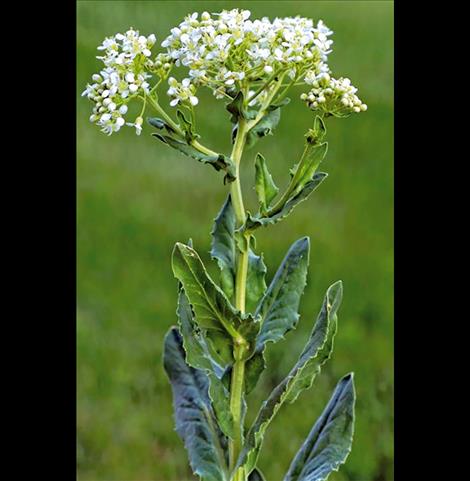New program launched to combat whitetop invasion
Hey savvy news reader! Thanks for choosing local.
You are now reading
1 of 3 free articles.
LAKE COUNTY – It looks harmless enough, maybe even pretty. Four delicate white petals form little flowers clustered together atop a tall green stem. From a distance, the flowers create a cauliflower looking shape. But – whitetop is anything but harmless in this country.
The invasive weed, a native of Eurasia, has the potential to reduce biodiversity, interfere with wildlife forage production, and it can be toxic to cattle. Without any natural predators, it can take over the land and choke out native plants.
“It’s getting worse each year,” said Lake County Weed Coordinator Tom Benson of the whitetop issue in the county. “Whitetop has the potential to render the land useless for agriculture production and it diminishes property values.”
In an effort to combat the problem, the Lake County Weed Control Department developed a program to help called the Lake County Whitetop Relief Program. It uses a three-pronged approach to help reduce the problem that includes public awareness, landowner education, and treatment. Reducing the cost of herbicide application is the main tool being utilized by the program.
“We are not trying to push herbicides, but for this purpose, I think this is all that we’ve got,” he said. Herbicides require persistence and are not a means to eradicate the problem, he explained, but herbicides are an effective management tool.
“Will we eradicate it? No,” he said. “With whitetop, eradication isn’t in the vocabulary, but we can reduce it.”
Weeds can usually be treated by pulling them out of the ground or mowing them down, and diligence in those areas can help with whitetop, but folks need to keep in mind that this species is a super weed, and it easily grows back if the entire root isn’t removed.
“You can pull it or mow it, but the underground root system will just increase,” he said. “It can look like you are accomplishing something when in reality you are not.”
Biological control agents that include several insect species are currently being tested, but they are not available yet. Flooding is another method, but it damages desirable plants. Planting competitive crops like alfalfa can reduce the weed.
Whitetop needs to be treated with herbicides every year.
“Many people throw their hands in the air and give up on this. It’s an ongoing process, and people have limited resources, but by doing nothing the problem gets worse,” he said.
The department wants to help people fight the whitetop battle by offering herbicides at a lower cost through the Lake County Whitetop Relief Program. To participate in the program, folks need to fill out an application with a description of the property.
“I will go out and verify that there is whitetop on the property,” Benson said. “We hope it’s not there, but if it is, we will sell them the herbicide at a reduced cost.”
The inspection is also used to help create a map.
“We are working to determine the extent of the infestation,” he said. “Right now, we have 8 to10 thousand acres that are infested.”
The program is open from May 2 to June 6 due to the life cycle of the plant.
“This plant grows during the winter, and it reaches maturity by the end of May,” he said. “By the first of June, it has already gone to seed. It’s a short window. If you spray after it has gone to seed, you risk creating a resistant plant.”
The weed spreads when the seeds are carried by birds, water or wind. Humans can spread the seeds through forage transport. Benson said that if goods like hay coming out of Montana have a high enough level of invasive weed contamination, an embargo can be placed on trade.
“We are an agricultural community,” he said. “If we lose the ability to export or move forage, it has huge consequences for the county, and it won’t affect just ranchers.”
Benson said he thinks the problem won’t lead to an embargo, but he said if it did happen, the consequences affect everyone.
“It would have a negative effect on grocery stores, auto dealers and other businesses because, if the rancher isn’t
productive, they don’t buy vehicles or hay equipment or anything else. It would create a domino effect.”
If people do nothing, the county could end up covered in whitetop.
“We owe it to future generations to handle this problem now,” he said, adding that he hopes the Whitetop Relief Program will help. He also hopes that it will alleviate some concerns.
“In the month of May, we’ve had 50 calls in a day with people asking, ‘What are you doing about the whitetop problem?’ I hope this addresses some of those concerns.”
The program is open to tribal and nontribal individuals that own, rent or lease ground in Lake County. For more program information, contact the Lake County Weed District at 406-883-7330.
















